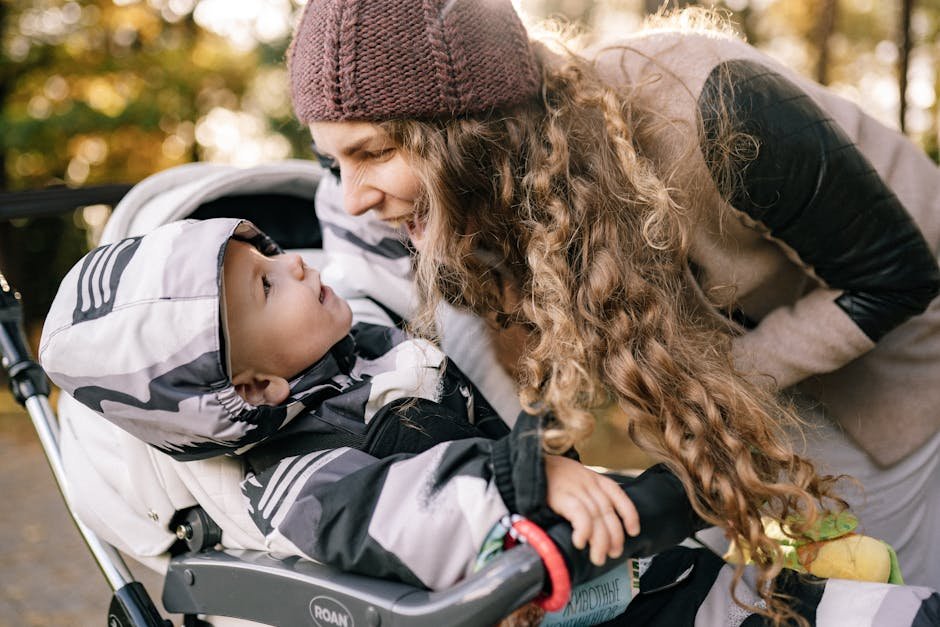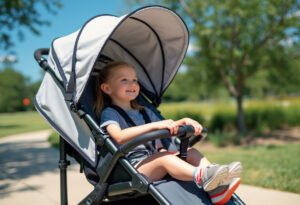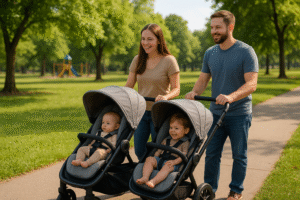Backward Facing Stroller: Top 5 Benefits for Happy Babies
Why Baby’s View Matters: The Importance of Backward Facing Strollers
Backward facing strollers provide essential eye contact and interaction between parents and babies, allowing infants to see their caregivers while on the move. If you’re evaluating stroller options in 2025, here’s what you need to know about parent-facing configurations:
- Recommended age range: Birth to 9 months
- Primary benefits: Improved parent-child bonding, reduced infant stress, better language development
- Key developmental support: Provides crucial head and neck support for infants
- Research finding: Studies show babies in parent-facing strollers are more likely to laugh, talk, and connect with parents
A backward facing stroller (also called parent-facing or rear-facing) positions your baby to look at you rather than the outside world. This orientation isn’t just about convenience—it’s about creating a secure environment that supports your child’s early development.
When babies can maintain eye contact with parents, they experience less stress and more opportunities for crucial early bonding. Research has shown that babies in parent-facing strollers engage in more conversation and connection with their caregivers, which supports healthy emotional and language development.
I’m James Mark, a stroller safety expert with over 10 years of experience evaluating and recommending backward facing stroller options for families with infants and young children. My work has focused on helping parents understand how stroller configurations impact infant development and security during those crucial early months.
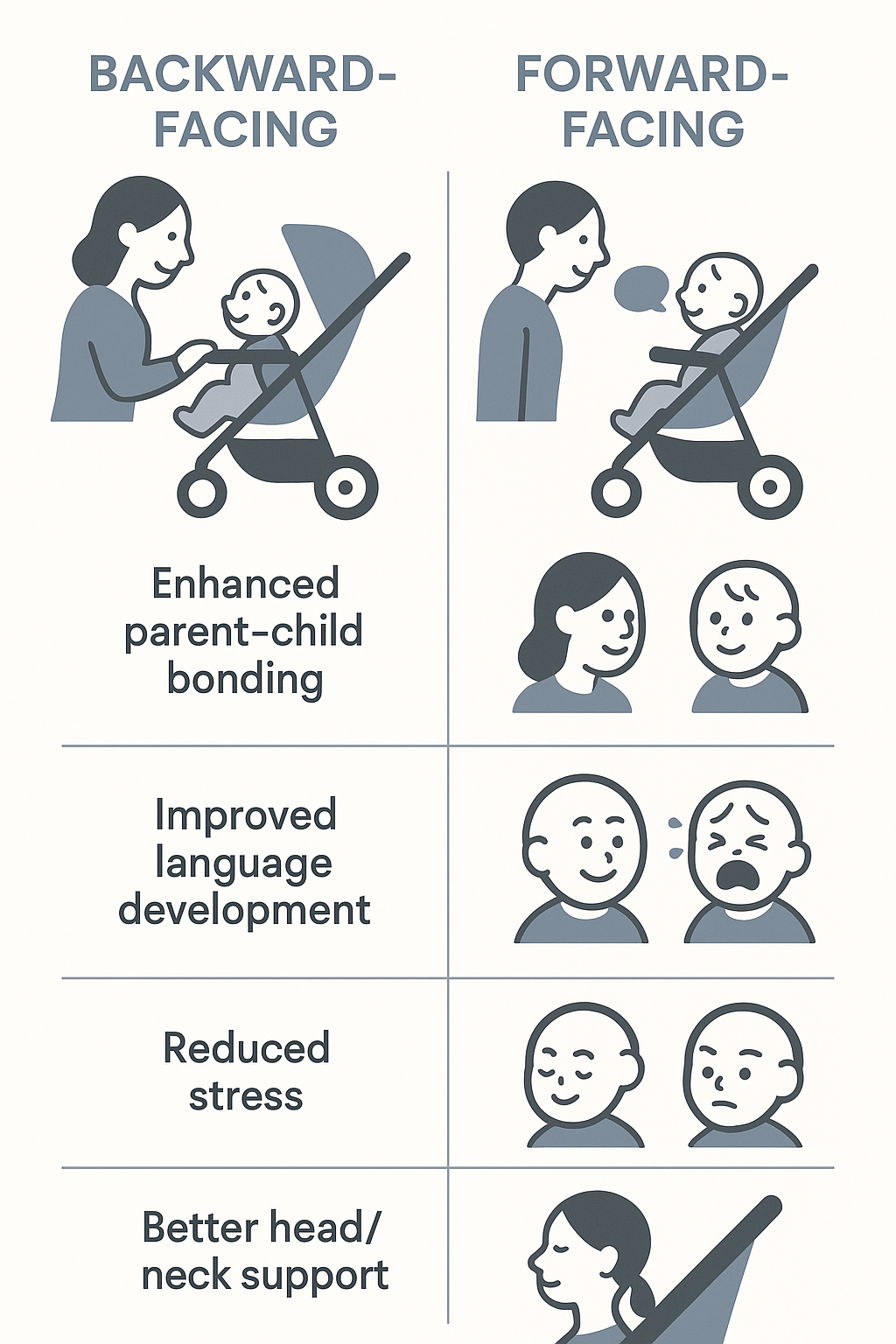
Related content about backward facing stroller:
– evenflo reversi lightweight reversible stroller leonis green
– reversible stroller
– ergobaby stroller snack tray
Understanding Backward Facing Strollers
When we talk about a backward facing stroller, we’re referring to a design where your baby sits facing you rather than facing the world ahead. You might also hear these called parent-facing, rear-facing, or reverse-facing strollers. This simple orientation difference creates a beautiful opportunity for connection during your daily trips together.
Unlike forward-facing models where babies watch the world go by, backward facing strollers create a cozy little bubble where your little one can gaze at their favorite sight—your face! This design choice isn’t just about convenience; it fundamentally shapes how your baby experiences those early outings.
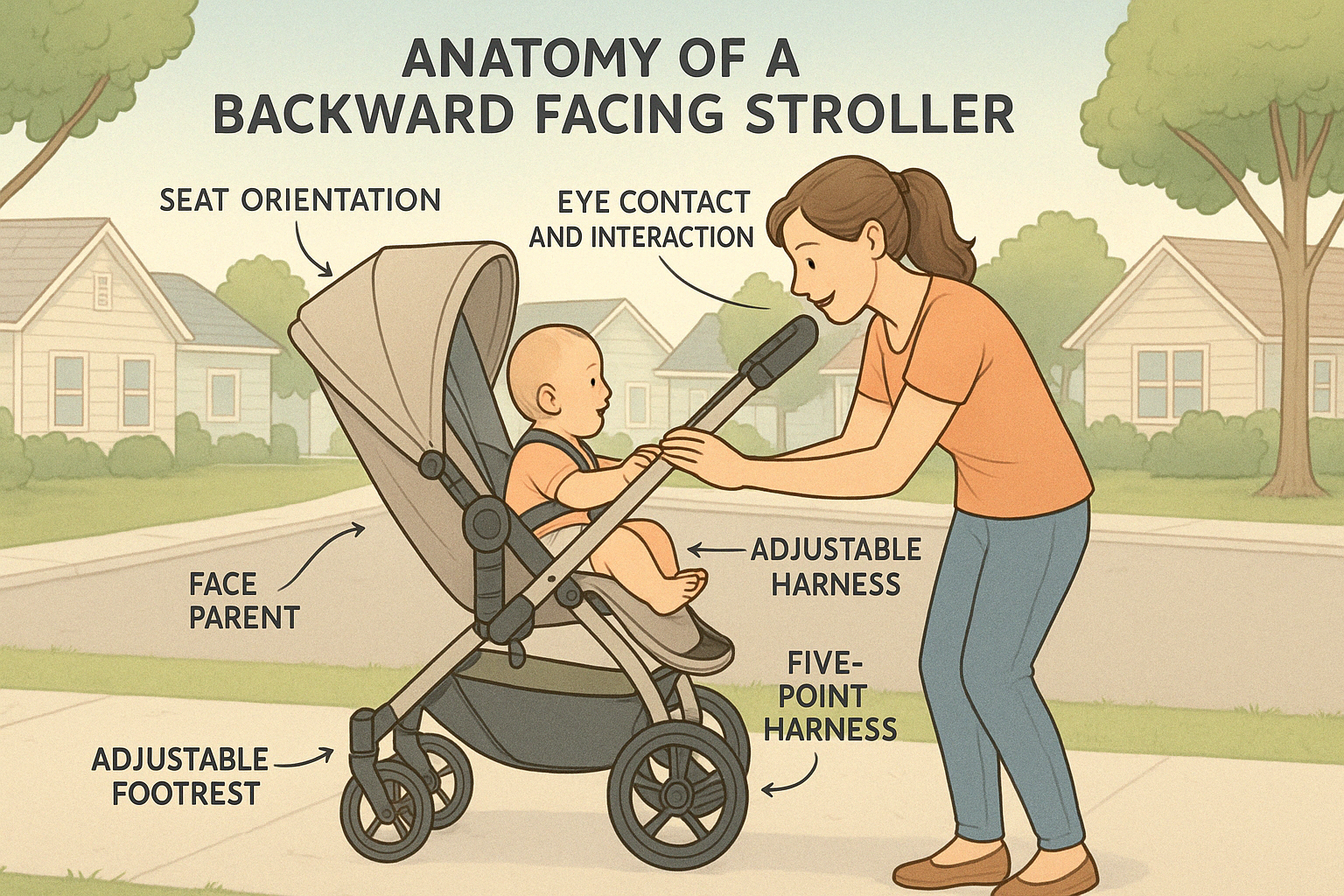
I love what Sarah, a first-time mom from Seattle, shared about her experience: “When my daughter was just two months old, I noticed how her face would light up whenever she could see me while we were out for walks. The backward facing stroller became our special connection time—I could talk to her, sing songs, and make faces, and she would respond with the sweetest coos and smiles.”
Here at BabbyStrollers.com, we’ve noticed many parents don’t realize just how important stroller orientation is until they’ve tried both styles. That constant visual connection with your baby isn’t just heart-warming—it’s actually supporting their development in meaningful ways.
Benefits of Using a Backward Facing Stroller
The perks of choosing a backward facing stroller go far beyond just being able to keep an eye on your little one. Research consistently shows real developmental and emotional advantages for babies who can maintain eye contact with their caregivers during outings.
Improved Emotional Bonding
Nothing beats those sweet moments of connection when your baby locks eyes with you and breaks into a gummy smile. A study in “Developmental Psychology” found that babies in parent-facing strollers were much more likely to laugh, babble, and engage with their parents compared to those facing forward.
Dr. Amanda Chen, a pediatric development specialist, explains it perfectly: “A reversible seat is a must-have feature for many parents looking for a stroller that will grow with their child. The face-to-face interaction during those critical first months helps establish secure attachment patterns that benefit children throughout their lives.”
Language Development Acceleration
Think about it—when your baby can see your face while you chat about the birds or the pretty flowers, they’re getting a full language lesson. They watch your lips move, see your expressions change, and make connections between sounds and emotions.
The research is pretty impressive here. Babies in backward facing strollers experience about 40% more verbal interaction with their caregivers than those facing forward. All those extra words and conversations during these critical developmental months can significantly boost their vocabulary and communication skills down the road.
Improved Safety Through Monitoring
With a backward facing stroller, you’ll always know if your baby’s hat has slipped over their eyes, if they’ve dropped their favorite teething toy, or if they’re showing signs they might be getting hungry. This immediate visual access means you can quickly respond to any needs before they become urgent.
This monitoring ability is especially valuable for babies with special needs or medical conditions requiring close observation. You can immediately notice changes in breathing, displaced medical devices, or signs of discomfort.
Research on infant stress in stroller orientation suggests that babies in forward-facing strollers often have higher levels of stress hormones, particularly in busy environments, compared to babies who can see their parents’ reassuring faces.
How Backward Facing Strollers Contribute to Baby’s Development and Safety
Beyond just the emotional warm-fuzzies, backward facing strollers offer practical physical and developmental benefits during those first precious months.
Crucial Head and Neck Support
Newborns are still working on those neck muscles! A backward facing stroller typically provides better support for those wobbly little heads and necks, as these models are specifically designed with younger babies in mind.
The recline positions in parent-facing configurations usually better accommodate infants who aren’t yet sitting independently. This proper positioning helps prevent uncomfortable slouching or head slumping, which can restrict airways and make for a cranky baby (and parent!).
Reduced Overstimulation
Have you ever noticed how overwhelming a busy shopping mall can be, even as an adult? Now imagine experiencing that with a brand-new nervous system that’s still figuring out how to process sensory information.
A backward facing stroller creates a gentle buffer between your baby and potentially overwhelming environments. Instead of being bombarded by passing scenery, traffic, and strangers, your little one can focus on the most comforting sight in their world—your face.
Dr. Michael Thompson, a pediatric neurologist, puts it this way: “Infants are still developing their ability to filter sensory input. A parent-facing stroller allows them to engage with the world gradually, using their caregiver’s face as an emotional reference point. This can significantly reduce stress responses in stimulating environments.”
Improved Security Through Visual Connection
Scientific research on infant development shows that babies use their caregivers’ expressions as emotional guides, especially in new situations. This “social referencing” helps babies understand how to respond to unfamiliar experiences.
In a backward facing stroller, your baby can easily check your face for reassurance when they hear a loud noise or see something new. This simple visual connection provides a sense of security that supports healthy exploration and helps them gradually adapt to the big world around them.
When to Transition from Backward Facing to Forward Facing
While backward facing strollers offer numerous benefits for young infants, there comes a time when most children benefit from transitioning to a forward-facing position. Understanding when and how to make this transition is essential for supporting your baby’s developing needs and curiosity.
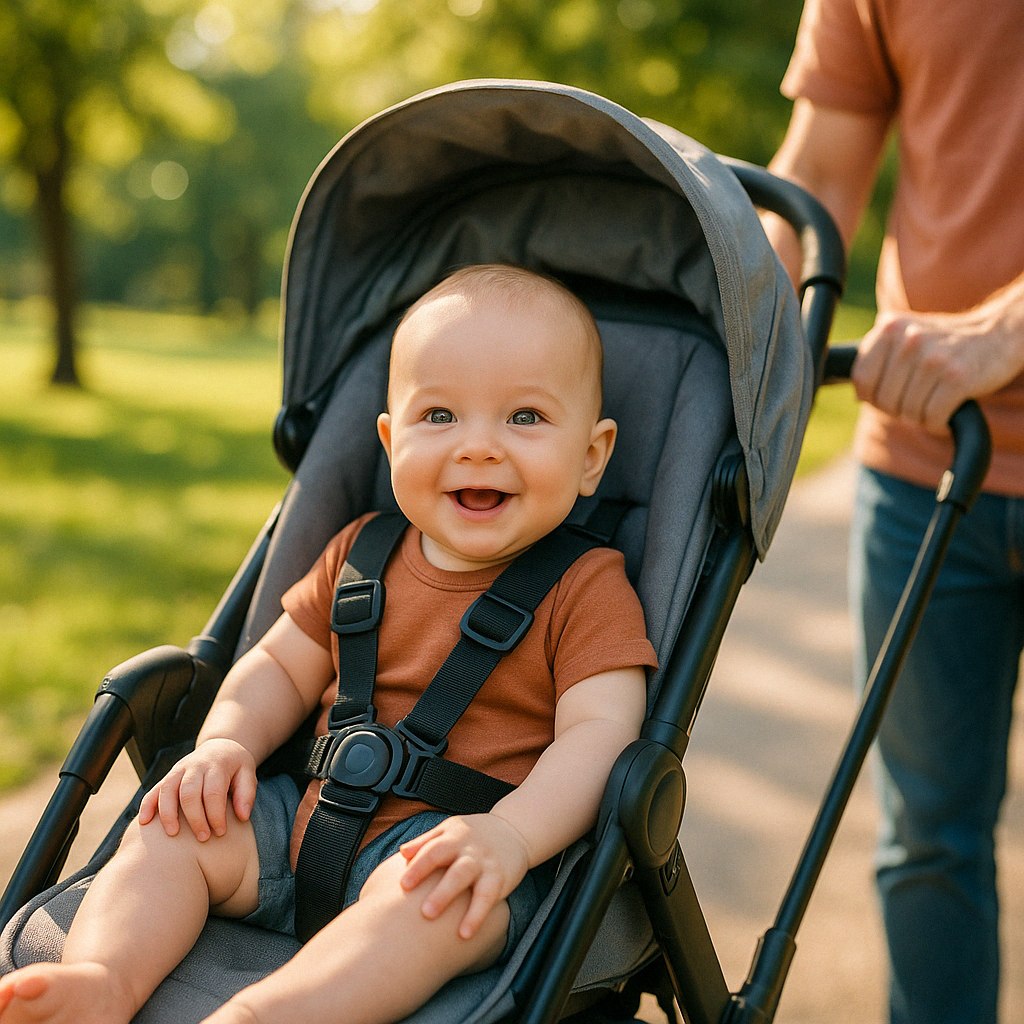
Age Recommendations
Most pediatric experts and stroller manufacturers recommend keeping babies in a parent-facing position from birth until approximately 6-9 months of age. This timeline isn’t arbitrary – it’s based on typical developmental milestones and the changing needs of growing infants.
Remember though, these are just guidelines, not strict rules. Every baby writes their own developmental story, and your little one’s transition should be guided by their individual progress rather than simply checking off months on a calendar.
As Emma Watson, a child development specialist, puts it: “The 6-9 month window is when many babies begin showing increased interest in their environment along with the physical development needed to support a more upright, forward-facing position. But some babies may be ready earlier, while others benefit from parent-facing configurations for longer periods.”
Many parents find that having a reversible stroller gives them the flexibility to switch between orientations as needed – forward-facing for stimulating trips, and backward-facing for quieter, connection-focused outings.
Developmental Milestones to Watch For
Instead of fixating on your baby’s age, pay attention to these developmental signposts that suggest readiness for a forward-facing position:
| Developmental Stage | Stroller Orientation | Key Indicators |
|---|---|---|
| Newborn to 3 months | Backward facing | Limited head control, needs maximum support, primarily focused on caregiver’s face |
| 4-6 months | Primarily backward facing | Beginning to develop head control, increasing alertness, still benefits from caregiver interaction |
| 6-9 months | Transitional period | Good head control, can sit with minimal support, shows interest in surroundings |
| 9+ months | Primarily forward facing | Strong sitting ability, actively curious about environment, enjoys new stimuli |
I’ve spoken with countless parents at BabbyStrollers.com who appreciate having this milestone guide rather than a strict age cutoff. One mom shared, “My first baby was ready to face forward at 7 months, but my second preferred facing me until almost 10 months. Having this chart helped me feel confident I was making the right choice for each child.”
The beauty of many modern strollers is their adaptability – with reversible seats that let you switch between configurations as your baby’s needs and moods change. This flexibility is particularly valuable during that 6-9 month transition window when babies might benefit from different orientations depending on the situation or their energy level that day.
Signs Your Baby is Ready to Face Forward
Watching for these four key readiness signals can help you determine when your baby might be ready for a new perspective on the world:
Independent Sitting Ability
One of the most important physical milestones indicating readiness is your baby’s ability to sit independently with good stability. This core strength typically develops between 6-8 months for most babies, though each child follows their own timeline.
Before switching to forward-facing, your little one should be able to maintain an upright sitting position without significant support and without slumping or tipping over. This strength isn’t just about comfort – it’s about safety too, as it helps them handle the natural movements and occasional bumps of stroller rides.
Strong Neck Control
Complete head and neck control is absolutely essential before transitioning to a forward-facing position. Your baby should be able to hold their head steady and turn it easily in different directions without support.
Think of it this way: in a backward facing stroller, you can see immediately if your baby’s head needs support. In a forward-facing position, you won’t have that same visual connection, so their neck muscles need to be strong enough to handle the job independently.
A mom named Jamie told us, “I knew my daughter wasn’t ready yet when I briefly tried forward-facing and noticed her head bobbing with every little bump in the sidewalk. We went back to our backward facing stroller for another month until her neck muscles strengthened.”
Increased Curiosity About Surroundings
Perhaps the most telling behavioral sign is when your baby starts showing active interest in the world beyond the stroller. You’ll notice them becoming little explorers – turning their head to look around while strolling, straining to see what’s happening beyond their current view, or even becoming frustrated by the limited visibility in the parent-facing position.
As one dad shared with us at BabbyStrollers.com: “We knew our son was ready to face forward when he started doing neck gymnastics in his backward facing stroller, trying to see everything happening around him. Once we switched him to forward-facing, he was so much happier—pointing at dogs, trees, and other children with such excitement!”
Seeking Environmental Stimulation
As babies develop, they naturally become more interested in environmental stimulation and less exclusively focused on their caregivers’ faces. This developmental shift often coincides with the appropriate time to transition to a forward-facing position.
You might notice your baby becoming more engaged with toys, responding enthusiastically to new sights and sounds, or showing a preference for novel experiences. These are all hints that your baby might benefit from the increased environmental exposure that a forward-facing stroller provides.
One mother described this transition beautifully: “Around 8 months, I noticed my daughter was less interested in our usual peek-a-boo games during our walks. She kept twisting around to see the world going by. When we finally switched our backward facing stroller to forward-facing, it was like she’d finded a whole new planet – her eyes were wide with wonder at everything she could now see!”
There’s no rush to make this transition. The intimate connection provided by a backward facing stroller offers valuable developmental benefits during those precious early months. When the time is right, your baby will let you know they’re ready for a new perspective on the world.
Key Features to Look for in a Backward Facing Stroller
When shopping for a backward facing stroller, certain features can make a world of difference for both you and your baby. At BabbyStrollers.com, we’ve helped thousands of parents find their perfect stroller match, and we’ve learned what truly matters in the day-to-day life with a little one.

Reversible Seats
The magic of modern strollers lies in their ability to transform as your baby grows. A reversible seat that easily switches between parent-facing and forward-facing positions gives you the best of both worlds.
Think of it as future-proofing your purchase. Your newborn can gaze adoringly at you during those precious early months, and later, when curiosity takes over, you can flip the seat to let them explore the world.
“I remember the first time we switched our daughter’s seat to forward-facing,” shares Maria from Chicago. “She was about eight months old and suddenly so interested in everything. The look of wonder on her face as she took in the neighborhood we’d walked through hundreds of times—it was like she was seeing it all for the first time!”
The best reversible seats can be switched in seconds without complicated maneuvers or engineering degrees. You’ll appreciate this simplicity when you’re standing in the rain with a fussy baby!
Safety Certifications
When it comes to your little one, safety isn’t just a feature—it’s the foundation. Look for strollers that meet or exceed standards set by ASTM International and the Juvenile Products Manufacturers Association (JPMA).
A secure five-point harness should cradle your baby snugly, while reliable brakes need to engage firmly even on slight inclines. The stroller frame should be sturdy without being unnecessarily heavy, and all materials should be non-toxic and free from harmful chemicals.
Safety isn’t always visible at first glance, so don’t hesitate to ask questions or research a model’s safety record before purchasing. Your peace of mind is worth the extra effort.
Adjustable Recline Positions
Babies have opinions about positioning long before they can voice them! A backward facing stroller with multiple recline options accommodates everything from naptime to curious observation mode.
Newborns need a nearly flat recline to support their developing spine and airways, while older babies often prefer a more upright position to take in the sights. The best designs allow smooth, one-handed adjustments—because your other hand will inevitably be holding a bottle, pacifier, or curious little fingers.
“My son has always been a stroller napper,” says James, a dad from Portland. “Being able to gently recline the seat without waking him has saved countless outings. It’s the little things that make such a big difference in daily life with a baby.”
Comfort Features
Comfort extends far beyond the basics when you’re spending hours pushing your little explorer. Backward facing strollers with thoughtfully designed comfort features can transform ordinary walks into delightful trips.
Padded, breathable fabrics keep your baby comfortable in various temperatures, while adjustable leg rests prevent that uncomfortable dangling-legs syndrome as they grow. An extended canopy shields delicate skin from harsh elements, and good suspension systems mean your baby isn’t jostled awake every time you roll over a sidewalk crack.
Don’t forget your own comfort too! Adjustable handlebar heights prevent stooped shoulders and aching backs, especially when parents of different heights share stroller duty. After all, a comfortable parent is a happy parent!
Considerations When Choosing a Backward Facing Stroller
Safety Standards
While we’ve touched on certifications, safety is an ongoing commitment from manufacturers. Check if your chosen model has ever been recalled or had safety concerns. At BabbyStrollers.com, we rigorously vet our inventory, but we still encourage parents to do their homework.
Beyond certifications, examine the stroller’s construction quality. Does it feel solid? Are there pinch points where tiny fingers could get caught? Does the harness adjust properly for your baby’s size? These practical safety aspects matter tremendously in daily use.
Ease of Use
Let’s be honest—parenthood brings enough challenges without wrestling an uncooperative stroller! Consider how the stroller performs in real-world scenarios.
Folding mechanism simplicity can save your sanity when you’re juggling a baby, diaper bag, and keys. One-handed folding systems are particularly brilliant for solo parent outings. Similarly, assembly requirements shouldn’t require an engineering degree or special tools.
The reality of life with babies is messy. Strollers with machine-washable, easily removable fabric components will look better longer. And that storage basket? Make sure you can actually reach it when the seat is reclined or facing you—a surprisingly common oversight in some designs.
Weight and Size
“I wish someone had told me to consider the weight more carefully,” admits Taylor, a mom of twins. “I chose a gorgeous, feature-packed stroller that I literally dread taking out because it’s so heavy. Now it mostly sits in our garage while I use our lighter backup stroller.”
A backward facing stroller under 20 pounds offers maneuverability without sacrificing stability. Consider where you’ll store it and whether it fits comfortably in your car trunk. A stroller that’s difficult to transport often becomes a stroller that rarely gets used.
Also consider your baby’s size trajectory. Some compact models might look perfect for your newborn but offer limited room for growth, potentially shortening the stroller’s useful lifespan.
Adaptability
The most practical strollers evolve alongside your growing family. Models compatible with infant car seats create seamless travel systems, eliminating the need to wake sleeping babies during transfers. Adjustable harness heights accommodate growth spurts, while convertible models can expand from single to double configurations—perfect if you’re planning siblings close in age.
Parental Lifestyle Considerations
Your daily reality should guide your stroller choice more than trendy features or brand names. City dwellers navigating narrow store aisles and public transport need different features than suburban parents who primarily load strollers into SUVs.
If you’re frequently solo parenting, prioritize features that make independent use easier. If you live where weather changes dramatically, look for models with included or available weather shields. And if storage space is limited in your home, a compact folding design might outweigh other considerations.
For parents who enjoy off-road trips, you might want to explore our guide on All-Terrain Stroller with Reversible Seat which covers options that handle everything from beach sand to forest trails while still offering the benefits of backward facing configurations.
The perfect stroller isn’t necessarily the most expensive or feature-laden—it’s the one that seamlessly integrates into your family’s unique lifestyle while keeping your baby safe, comfortable, and happy.
Comparing Backward Facing and Forward Facing Strollers
When it comes to stroller orientation, parents often wonder which direction is best for their little one. The truth is, both backward facing strollers and forward-facing models have their place in your parenting journey – the key is understanding when each option shines.
Differences in Parent-Child Interaction
The magic of a backward facing stroller lies in the continuous connection it creates between you and your baby. Those precious face-to-face moments aren’t just heartwarming – they’re developmental gold.
“I’ll never forget those morning walks with my daughter facing me,” shares Monica, a mom from Portland. “She’d study my face so intently, and we’d have these little ‘conversations’ where I’d talk and she’d respond with the sweetest coos and smiles. It felt like our special time together.”
In parent-facing mode, you can immediately spot if your baby is uncomfortable, hungry, or just wanting some attention. This positioning creates what child psychologist Dr. Elena Sanchez calls a “conversational bubble” – a space where natural back-and-forth exchanges happen effortlessly. These small interactions build up over time, strengthening your bond while supporting language development.
Forward-facing strollers, by contrast, create more of a shared experience where you’re both looking outward. While this limits direct interaction, it offers older babies the excitement of finding the world around them – something they crave as they develop.
Impact on Development
The way your baby faces in their stroller can influence different aspects of their development in fascinating ways.
When using a backward facing stroller, your baby gets a front-row seat to the most interesting show in their world: your face! This positioning tends to support earlier language skills since babies can watch how your mouth moves when forming words. They also benefit emotionally, using your facial expressions as a guide for how to react to new experiences – a process developmental experts call “social referencing.”
“Babies are natural scientists,” explains pediatric neurologist Dr. James Wilson. “In those early months, your face is their primary research subject. They’re constantly reading your expressions to learn about their world.”
Forward-facing configurations shine when it comes to environmental findy. As babies approach their first birthday, their curiosity about the world explodes. Facing forward gives them panoramic access to passing scenery, interesting strangers, and neighborhood pets – all of which feed their growing appetite for new information.
Research from the University of Dundee found that younger babies in forward-facing strollers showed higher stress indicators compared to those facing their parents. However, this difference diminished as babies approached their first birthday, suggesting that developmental readiness plays a key role in determining the best orientation.
Safety Aspects
Both stroller orientations offer different safety advantages worth considering.
A backward facing stroller gives you constant visual access to your baby – meaning you’ll immediately notice if they spit up, drop a toy, or show signs of discomfort. This configuration also naturally shields your little one from direct wind, unexpected sun glare, and other environmental elements that might cause discomfort.
“The parent-facing position was absolutely essential when my son was diagnosed with reflux,” explains Jordan, a father of two. “I could monitor him constantly and react immediately if he showed any signs of distress.”
Forward-facing strollers have their own safety benefits, especially as babies grow. Older infants and toddlers with good head control often prefer a more upright position, which forward-facing configurations typically provide better. These models also usually offer more leg room for growing toddlers, preventing discomfort during longer outings.
Advantages and Disadvantages of Each Type
Understanding the pros and cons of each orientation can help you make the best choice for your baby’s current stage.
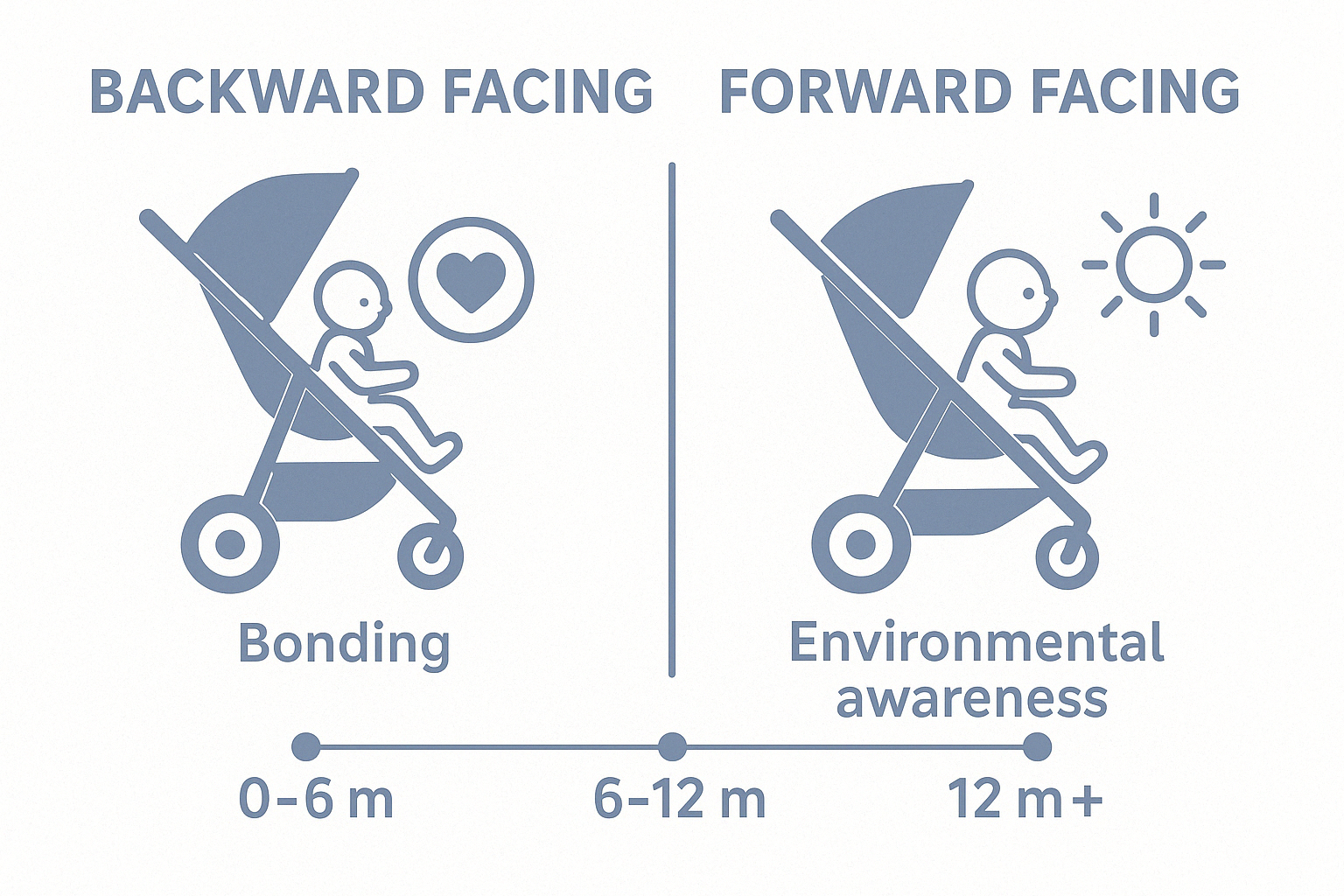
With a backward facing stroller, you’ll create a cozy bubble for your baby that supports emotional security and language development. Babies often sleep more peacefully when they can see their caregiver’s familiar face, and you’ll have the peace of mind that comes with being able to monitor your little one constantly.
“We noticed our daughter would babble and ‘talk’ to us so much more when facing us in the stroller,” shares Amelia from Chicago. “It was like having a conversation partner on our morning walks, even before she could say actual words.”
However, parent-facing strollers do have limitations. As your baby grows, they may become frustrated by their limited view of the world around them. Some models also provide less legroom in the parent-facing position, which can become uncomfortable as your baby gets bigger. Depending on which direction you’re walking, the sun might shine directly into your baby’s eyes more often in this configuration.
Forward-facing strollers become increasingly valuable as your baby’s curiosity about the world grows. This position offers rich environmental stimulation and supports your child’s developing independence. Many parents find their older babies stay content for longer walks when they have the entertainment of watching the world go by.
“Around 10 months, our son started twisting around in his backward-facing seat, clearly trying to see where we were going,” remembers Thomas, a dad from Austin. “When we switched him to forward-facing, he was suddenly pointing, babbling, and engaging with everything we passed. It was like watching his world expand before our eyes.”
The downside? Forward-facing configurations significantly reduce face-to-face interaction, making it harder to monitor your baby’s needs or engage in those valuable communicative exchanges. Some sensitive babies may become overwhelmed by unfiltered environmental stimulation, and research suggests younger infants may experience more stress in this position.
The beauty of modern stroller design is that many models, like those we offer at BabbyStrollers.com, feature reversible seats that give you the best of both worlds. This flexibility allows you to adapt to your baby’s changing needs and preferences as they grow, rather than being locked into a single configuration.
Enhancing Bonding Through Backward Facing Strollers
There’s something truly magical about watching your baby’s face light up when they see you. That’s exactly what makes backward facing strollers so special – they create countless opportunities for meaningful connection during everyday outings. These moments aren’t just heartwarming; they’re building blocks for your child’s emotional and cognitive development.
The Importance of Eye Contact
When your baby can see your face during stroller time, something remarkable happens. Those little gazes aren’t just cute – they’re powerful building blocks for your baby’s developing brain.
“Your baby loves seeing you,” explains developmental psychologist Dr. Rebecca Thompson. “This isn’t just a sentimental observation—it’s backed by neuroscience. When infants engage in mutual gaze with their caregivers, specific neural pathways associated with social cognition and emotional processing are activated and strengthened.”
I remember pushing my nephew in a backward facing stroller through the park last spring. The way his eyes would lock with mine, his tiny smile blooming whenever I made a silly face – these weren’t just sweet moments. They were strengthening his sense of security and our bond with every glance.
Research consistently shows that babies who experience regular, responsive eye contact develop better emotional regulation skills. A backward facing stroller transforms an ordinary walk into hundreds of micro-moments of connection that collectively build secure attachment – something every parent hopes to establish with their child.
Communication Opportunities
Think about the difference between talking to someone face-to-face versus talking to the back of their head. That’s essentially what we’re discussing when comparing stroller orientations! When your baby faces you, conversation flows naturally and abundantly.
Parents instinctively talk more to babies when they can see their reactions. You’ll find yourself narrating your journey (“Look at that fluffy dog across the street!”), singing songs with animated expressions, or responding to your baby’s coos as if you’re having a real conversation. And guess what? You are!
Melissa, a mother of three who shared her experience with us, said: “Our morning walks in our backward facing stroller became our special time. I’d point out birds and trees, sing silly songs, and my daughter would ‘answer’ with her own babbles. By 10 months, she was clearly trying to repeat words I used regularly during our walks.”
This increased verbal interaction has measurable effects on language development. Studies show babies who experience more direct verbal engagement develop larger vocabularies, earlier sentence formation, and stronger pre-literacy skills. All from something as simple as stroller orientation!
Emotional Security
Beyond the obvious communication benefits, backward facing strollers provide babies with a secure emotional base as they encounter the world. This is particularly valuable in unfamiliar or stimulating environments where little ones might otherwise feel overwhelmed.
Babies naturally practice something psychologists call “social referencing” – they look to trusted caregivers’ facial expressions to interpret unfamiliar situations. Is that dog friendly or scary? Is that loud noise dangerous? Your baby checks your face for the answer. When they can easily see your reassuring smile, they develop greater confidence in new experiences.
One father shared this touching observation: “When we took our son to a crowded farmers market for the first time, I noticed how he would look at my face whenever there was a loud noise or someone approached. Seeing me smile and respond calmly seemed to reassure him that everything was okay, and he quickly became comfortable in the busy setting.”
This security creates a beautiful cycle of development: babies who feel safe are more likely to engage with their environment with curiosity rather than fear, which supports cognitive development and builds emotional resilience. Your backward facing stroller isn’t just a transportation tool – it’s a portable safe haven from which your baby can confidently explore the world, always with the reassurance that you’re right there, smiling back at them.
Frequently Asked Questions about Backward Facing Strollers
Why is a backward facing stroller beneficial for infants?
When you’re pushing your little one around the neighborhood, having them face you in a backward facing stroller creates a special connection that goes beyond just transportation.
During those precious first 6-9 months, babies are still developing crucial neck and head control. The parent-facing position provides the proper support they need during this developmental stage. Think about it – when your baby can see your face, their world feels safer and more secure.
“I noticed my daughter would calm almost instantly when she could see my face during our walks,” shares Maria, a mother from Portland. “Even when we passed construction noise that would normally startle her, she’d look at my reassuring smile and stay relaxed.”
The face-to-face interaction is like a mobile language class for your baby. They’re not just hearing your words but watching how your lips move and how your expressions change. This visual component of language learning gives them a headstart on communication skills that will serve them throughout life.
Research backs this up too. Studies show babies experience less stress in unfamiliar environments when they can see their caregivers. Your familiar face acts as an emotional anchor in a world that’s constantly new and sometimes overwhelming to them.
As pediatrician Dr. James Wilson explains: “Infants are still developing their ability to filter and process sensory information. Having a familiar face as their primary visual focus helps them manage potential overstimulation and builds their sense of security, which is foundational for healthy exploration and learning.”
At what age should I switch my baby to a forward facing stroller?
There’s no magical date on the calendar when your baby suddenly needs to face forward. Most babies are ready for this transition somewhere between 6-9 months, but watching for developmental cues is more important than watching the clock.
Your baby is probably ready for forward-facing trips when they:
– Can hold their head up confidently without wobbling
– Sit up independently without tipping over
– Show curiosity about the world around them by turning to look at sounds
– Seem frustrated in the parent-facing position, twisting to see what they’re missing
The beauty of modern strollers is that many offer reversible seats, giving you flexibility as your baby grows. As Tommy, a father of twins, told us: “Some days my son wants to explore the world, while other days he’s tired and prefers seeing my face. Having a backward facing stroller that can switch directions has been a lifesaver.”
Many parents find a gradual transition works best. You might use the parent-facing position during naptime strolls or in busy, overwhelming environments, while switching to forward-facing when your baby is alert and curious about their surroundings.
At BabbyStrollers.com, we often recommend strollers with easy-to-reverse seats for this very reason. Your baby’s preferences might change even during a single walk around the park!
Are there any disadvantages to using a backward facing stroller?
While backward facing strollers offer wonderful benefits for you and your baby, they do come with a few practical challenges worth considering.
Storage access can sometimes be tricky in parent-facing mode, with some models making it harder to reach the basket underneath. This might seem minor until you’re juggling a fussy baby while trying to retrieve a pacifier from the bottom of your diaper bag!
As your little one grows, you might notice they have less leg room in the parent-facing position. Babies grow surprisingly fast, and those kicking legs need space to stretch.
Weather considerations matter too. Depending on which direction you’re walking, your baby might get more direct sunlight in their eyes in a backward-facing position. And in windy conditions, they might catch more breeze directly on their face.
From a developmental perspective, around 6-9 months, many babies develop an insatiable curiosity about the world. As Jennifer from Chicago shared: “My son literally started twisting himself around in his backward facing stroller trying to see everything we passed. It was clear he was ready for a new view!”
Some more active babies simply prefer the stimulation of watching the scenery go by. As they grow, seeing the environment helps them develop spatial awareness and understand how the world fits together.
The good news? These challenges don’t mean you need to abandon the benefits of parent-facing configurations entirely. A stroller with reversible seating gives you the flexibility to adapt to your baby’s changing needs and preferences, ensuring comfortable trips for both of you throughout their early years.
Parenting isn’t about finding perfect solutions – it’s about finding what works best for your unique baby and family situation. With the right stroller, you can enjoy those face-to-face smiles early on and support their growing independence when they’re ready to face the world.
Conclusion
The journey of selecting the right stroller orientation is much more than a simple shopping decision—it’s about understanding and responding to your baby’s changing developmental needs as they grow.
For those precious early months, a backward facing stroller offers invaluable benefits that support your little one’s development in profound ways. That face-to-face connection creates a special bubble where bonding flourishes, communication blossoms, and your baby feels secure even in new environments. There’s something magical about seeing your baby’s eyes light up when they spot you during a neighborhood stroll—a moment that reinforces the deep connection you’re building together.
As your little explorer develops stronger neck muscles, sitting abilities, and a growing curiosity about the world around them, you’ll likely notice them straining to see more of their surroundings. This natural shift toward environmental engagement signals they might be ready for more forward-facing trips, allowing them to find the world from a new perspective.
Here at BabbyStrollers.com, we’ve seen countless families benefit from investing in versatile strollers with reversible seating options. These adaptable designs truly grow with your child, giving you the freedom to switch orientations based on your baby’s mood, the specific outing, or even the time of day. Some babies still prefer facing mom or dad when they’re tired or overwhelmed, while eagerly facing forward when they’re feeling adventurous.
While we’ve shared general guidelines about when to transition between positions, your baby is unique. Those little cues they give you—their expressions, movements, and vocalizations—are your best guide for determining what configuration works best at any given stage. Trust your instincts and your growing understanding of your child’s preferences.
For families watching their budget while still wanting this versatility, we’ve put together a helpful resource on Affordable Reversible Strollers that showcases quality options that won’t break the bank.
Parenthood brings countless decisions each day, from the monumental to the mundane. Your choice of stroller orientation might seem small in the grand scheme of things, but it represents something beautiful—your commitment to meeting your child where they are developmentally and helping them engage with the world in ways that feel secure and exciting.
With the right stroller, those daily walks become more than just a way to get fresh air—they transform into precious moments of connection, conversation, and findy that both you and your baby will treasure. Whether facing you with wide eyes and happy babbles or facing forward with excited pointing and curious glances back at you for reassurance, these shared journeys are building the foundation for a lifetime of exploring the world together.

